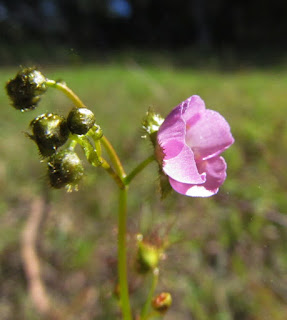 We have a patch of sundews Drosera peltata ssp auriculata growing on a grassy slope that gets morning sun and I have been waiting for the flowers . Today the first of the flowers opened and the sun was sparkling on the "dew" drops. I noticed when I checked the photo there is an insect (looks like a mosquito) caught on one of the leaves.
We have a patch of sundews Drosera peltata ssp auriculata growing on a grassy slope that gets morning sun and I have been waiting for the flowers . Today the first of the flowers opened and the sun was sparkling on the "dew" drops. I noticed when I checked the photo there is an insect (looks like a mosquito) caught on one of the leaves.This sub-species is found throughout the eastern states and in NZ where as D.peltata ranges through Sri Lanka SE Asia, Japan, New Guinea and Australia.
Around the middle of the day a pair of Yellow-tailed Black Cockatoos announced they were in the area with their unmistakable call as they flew in, so grabbed the camera and headed in the direction of their calls. The pair were in the trees on the west of the house and I was able to locate them from the noise of branches being ripped apart as they worked to get to the wood borer larva that are their favourite food. The larva could be from one of the moth species, or beetle larva, they are not fussy all are tasty morsels.
Yellow-tailed Cockatoos Calyptorhynchus funereus funereus are the largest of the three cockatoos that we have in the area and are often sighted flying over or in the tree tops and it is when they are grubbing that they are in a position for photos. As well as grubs they are partial to seeds and have found a bonus food supply in pine plantations where they are not particularly welcome or in orchards for their dessert.
They range from central Queensland through south-eastern Australia including Tasmania.
Late this afternoon a pair of Wood or Maned Ducks were on the verge of our road frontage where they are often seen foraging in the grass. This pair raised one duckling earlier in the year but it has now departed and they are empty nesters again. This is one of our most commonly seen ducks as they are foragers on grassland more that water birds although they like a source of water to be nearby. They are found throughout the continent but more numerous away from the centre.
 |
| Male on the left |





Love the sundew photos, Ian and the camouflage colours of the butterfly in the previous post are amazing.
ReplyDeleteThank you for the kind comments I am really enjoying posting the nature that is around here day in day out and the opportunity to visit other post such as yours. I like being able to travel with you around the English countryside and see such a varied wildlife to Australia. Loved your heron photos.
ReplyDelete